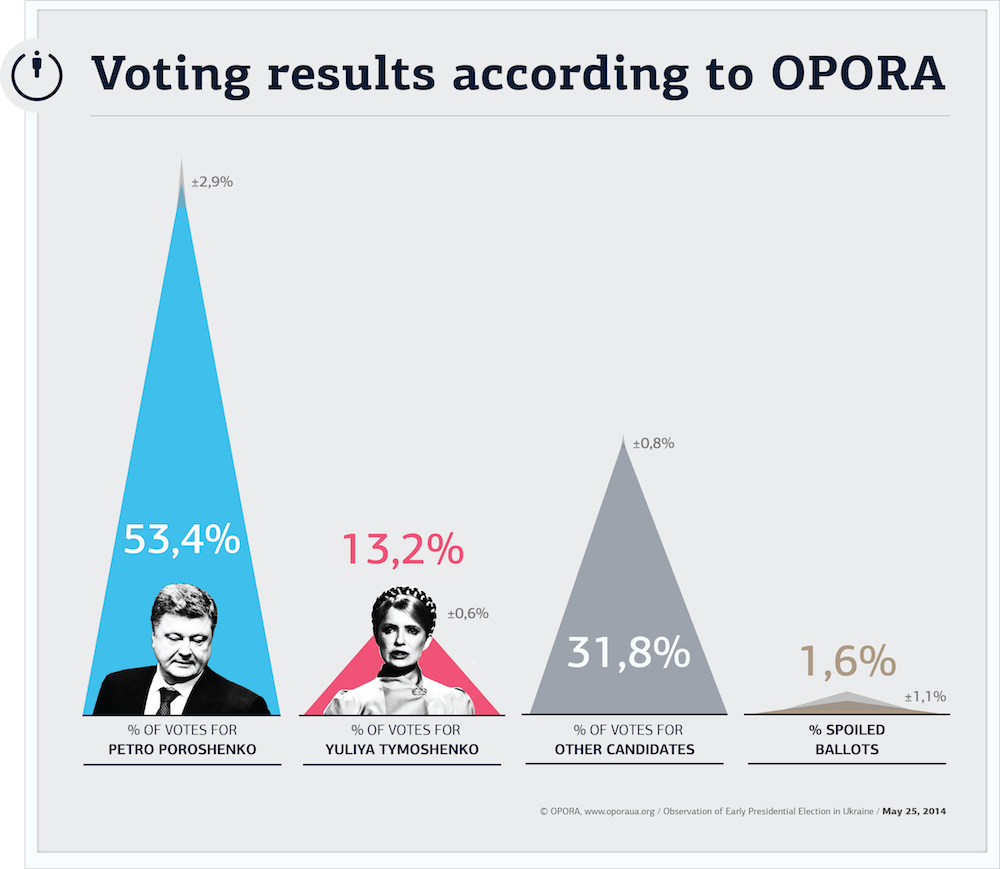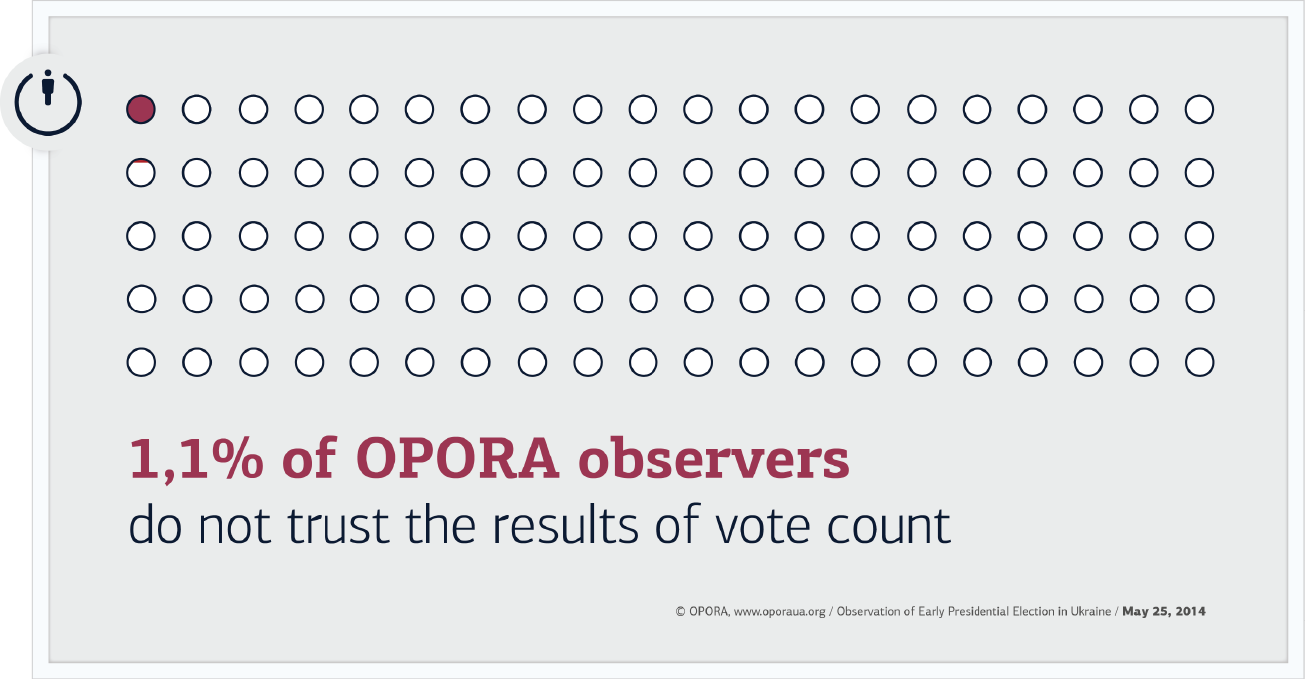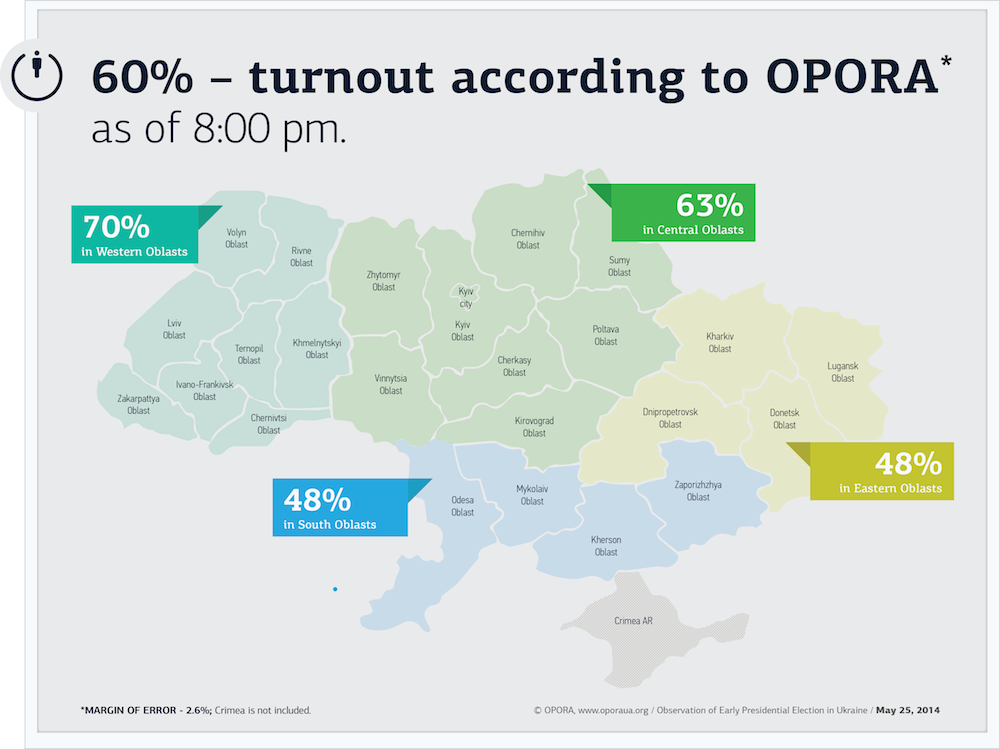Parallel Vote Tabulation Results from Civil Network OPORA
OPORA's accredited and specially-trained observers analyzed the election process from 07:15 until the completion of vote tabulation at the polling stations. In conclusion, they sent 9 reports to OPORA's call-center, concerning
- the conduction of the morning meeting
- voter turnout as of 12:00, 16:00, and 20:00 (or the end of voting, if later)
- violations during voting and vote tabulation
- election results
Parallel vote tabulation (PVT) is based on statistical sample and is not a poll. It is a record of preliminary official data taken from protocols, which contain voting results of more than 1.3 million voters in all oblasts (including Donetsk and Luhansk), who participated in Presidential Election.
PVT is conducted independently by the Civil Network OPORA in order to generate unbiased information about the accuracy of official results of voting during the presidential election, regardless of the winner.
On the basis of reports from 1,347 of 1,404 our PVT observers, OPORA affirms with 99% confidence that when the CEC announces the final results of presidential election, they will be the following:
- Poroshenko – 53.4% of votes;
- Tymoshenko – 13.2% of votes;
- Other candidates – 31.8% of votes;
- 1,6% of bullots will be considered invalid.


Typical Violations Reported During the Voting Process and Vote Count
During the Election Day, OPORA observed whether precinct election commissions adhered to the main election procedures. According to gathered data, election commissions did violate certain regulations of the law, but these incidents were not widespread and did not influence the election results.
Almost 20% of election commissions commenced the preparatory meeting too early (more than 45 minutes before the polls opened), thereby limiting the possibility of official observers to control the course of the morning meeting. Almost 7% of PECs failed to fulfill their duty and record protocols of the preparatory meeting. Almost 5% of PECs lacked official stamps. In 13% of polling stations, seals on safes with ballots were broken during the preparatory meetings. According to data collected by observers, almost 4% of polls failed to open at 08:00 due to organizational complications.
During the first hours of the voting (from 08:00 to 12:00), the most widespread violations were attempts to issue ballots without prior passport verification and attempts to vote without having the legal right to vote. Such incidents were reported only at 7% of polls.
At 4% of polling stations, the secrecy of voting was violated. In 4% of polls, unauthorized persons were present at the polling place. In 3% of polls, voters tried to take ballots out of the polling place.
From 12:00 to 16:00, the most common violations were the same as in the morning: attempts to issue ballots without prior passport verification and attempts to vote without having the legal right to vote. However, such incidents were not widespread and were noticed only at 6% and 4% polling stations respectively. Individuals not authorized to be present at the polling place were documented at 3% of polls. Violation of the voting secrecy was noticed only at 3% of polls. Only at 2 % of polls did voters attempt to take ballots out of the polling place.
During the last four hours of voting (16:00-20:00), OPORA's observers reported attempts to issue ballots without passport verification at 4% of polling stations. At almost 6% of polls, voters tried to get ballots without having the legal right. Secrecy of voting was violated at 2% of polls.
At 6% of polling stations, OPORA noticed voters still waiting in queues as of 20:00 on 25 May. According to the legislation, the PEC is obliged to allow all the voters inside of the polling station at the official close of polls to vote. According to the observers, many polling stations continued to operate until midnight. The longest queues were in the cities of Kyiv and Luhansk.
At 2% of polling stations, OPORA reported violations of the vote count. Simultaneously, at almost 9% of polling stations, observers could not decipher marks on ballots during the vote count.
According to the observation results, OPORA's observers reported non-confidence in the vote count results only at 1% of polls.


Voter Turnout on the Election Day (Calculated by OPORA)
Along with parallel vote tabulation, Civil Network OPORA analyzed voter turnout as of 12:00, 16:00, and20:00. Only open and functioning polls were taken in account.
The average voter turnout for the 2014 special presidential election in Ukraine was 60%[1] (as of 20:00 PM), what is 7,21% less than for the 2010 presidential election (67.21% in the first round), and 14.92% less than for the presidential election in 2004.
Table:
Dynamics of Voter Participation on Election Day in 2010 and 2014
|
2010 Presidential Election (First Round) |
2014 Special Presidential Election |
|
turnout as of 11:00 AM |
turnout as of 12:00 PM |
|
16.87 % |
25 % |
|
turnout as of 3:00 PM |
turnout as of 4:00 PM |
|
47.60 % |
45 % |
|
turnout as of 8:00 PM |
turnout as of 8:00 PM |
|
66.76 % |
60 % |
Voters in western oblasts of Ukraine were the most active (Lviv, Ivano-Frankivsk, Zakarpattia, Ternopil, Khmelnytskyi, Rivne, Volyn, and Chernivtsi oblasts) at 70%; and in central Ukraine (Vinnytsia, Zhytomyr, Cherkasy, Dnipropetrovsk, Kyiv, Kirovohrad oblasts and Kyiv city at 63%. The turnout in the East (Donetsk, Kharkiv, Sumy, Chernihiv, and Luhansk oblasts) and South (Odesa, Kherson, Mykolaiv, and Zaporizhzhia oblasts) was 48%.
Voters were generally the most active in the morning. As of 12:00, the turnout was 25%, and was equally high in all regions of Ukraine: 22% in the South and East, 25% in the West, and 27% in the Center. In the afternoon, the turnout reached 45% (as of 16:00), and in the regions participation increased in the West (52%) and in the Center (47%), and was higher than in South and East (37% in both regions).

[1]The statistical margin of error is not larger than 2.6 %.